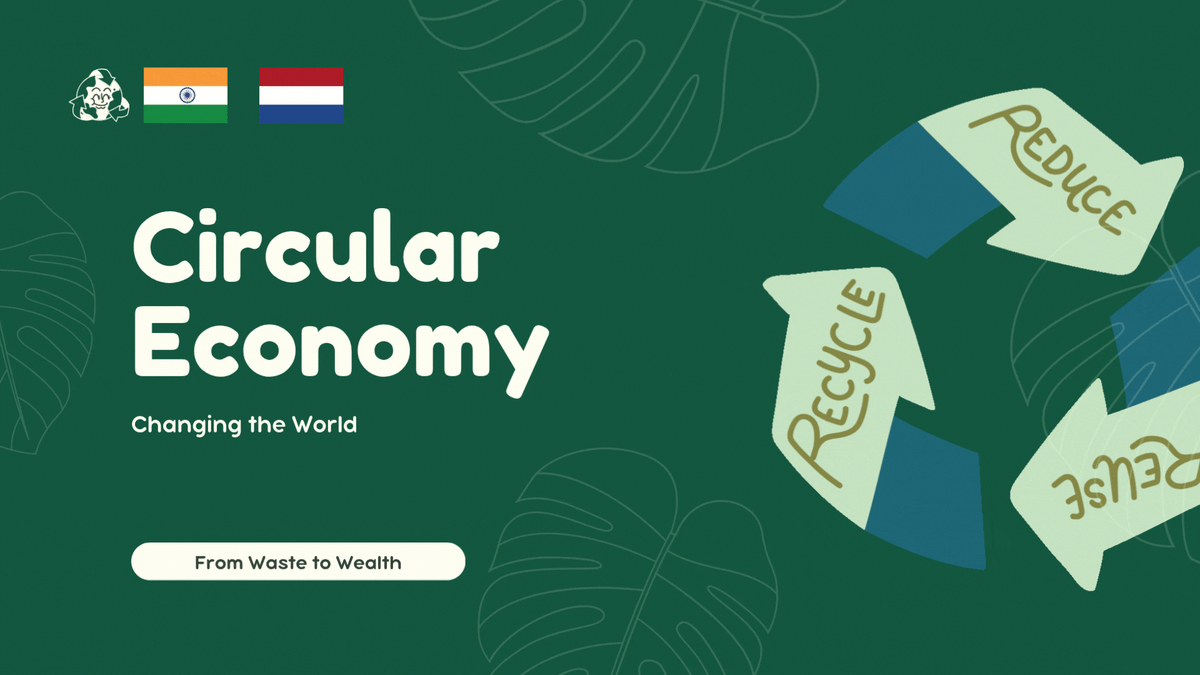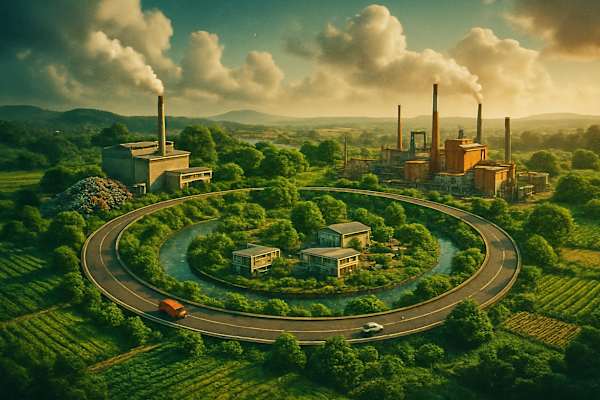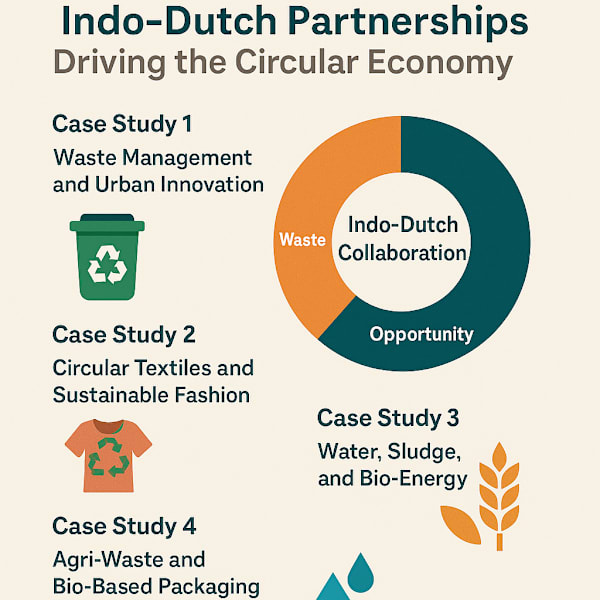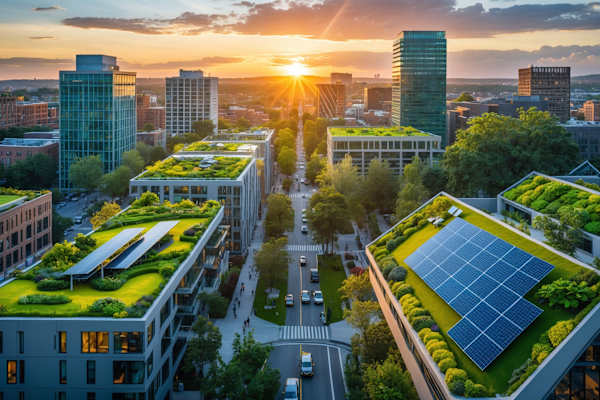As the global climate and resource crisis intensifies, the concept of a circular economy is no longer optional. It is essential. In this context, India and the Netherlands are forging a meaningful partnership that brings Dutch innovation together with India’s scale and urgency, demonstrating how international cooperation can accelerate sustainable transformation.
For Dutch sustainability professionals, the Indo-Dutch dynamic offers both opportunity and responsibility: to co-create scalable solutions, support local adaptation, and foster inclusive green transitions.
♻️ What Is the Circular Economy?
Unlike the traditional linear economic model that ends in waste, the circular economy promotes a closed-loop system where:
- Products are designed for reuse, repair, and recyclability
- Waste becomes a resource
- Systems focus on efficiency, regeneration, and resilience
It’s about rethinking not just products, but business models, supply chains, and community impact.
🇮🇳🤝🇳🇱 Why Indo-Dutch Collaboration Makes Sense
- The Netherlands has a national strategy to become fully circular by 2050 and leads in sectors like urban water management, bioplastics, green chemistry, and eco-design.
- India, with its rapid urbanization and environmental challenges, presents both a testing ground and a vast market for adaptive circular innovations.
This complementarity turns collaboration into impact at scale.
Let us look at some case studies.
📦 Case Study 1: Waste Management and Urban Innovation
India generates over 62 million tons of municipal solid waste annually, much of which is unmanaged. Dutch companies are helping introduce:
- Decentralized waste processing hubs, equipped with AI-powered sorting and composting tools.
- Projects like the Urban Living Lab in Bangalore, where Dutch and Indian engineers collaborate on real-time data collection and smart segregation systems.
- Tech-transfer initiatives around anaerobic digestion and bio methanation from Dutch municipalities like Amsterdam and Rotterdam, adapted to Indian urban density.
Dutch players bring proven models of citizen engagement, digital mapping, and waste logistics that Indian cities can scale and contextualize.
👗 Case Study 2: Circular Textiles and Sustainable Fashion
India is one of the largest textile producers globally—but also a significant generator of pre- and post-consumer textile waste. The Netherlands, as a hub for sustainable fashion innovation, has been instrumental in:
- Supporting the Circular Apparel Innovation Factory (CAIF), which fosters co-creation between Dutch designers and Indian manufacturers.
- Piloting fiber-to-fiber recycling technologies that can transform discarded garments into new fabric with minimal degradation.
- Promoting eco-labelling and traceable supply chains to help Indian producers tap into European green markets.
Collaborations with Dutch institutions like AMFI (Amsterdam Fashion Institute) are also helping Indian brands redesign for circularity from the start.
💧 Case Study 3: Water, Sludge, and Bio-Energy
India’s sanitation and water treatment needs are massive, especially in rural and semi-urban regions. Dutch expertise is helping:
- Design sludge-to-energy plants that convert toilet and sewage waste into usable biogas and fertilizers.
- Create modular decentralized wastewater systems, suitable for Indian peri-urban areas.
- Collaborate under the Namami Gange initiative to deploy Dutch innovations like aquafer recharge zones and floating wetlands for natural filtration.
The Dutch philosophy of "water as a resource", when paired with India’s policy push for integrated water management, leads to systems that are both resilient and regenerative.
🌾 Case Study 4: Agri-Waste and Bio-Based Packaging
India generates an estimated 500 million tons of agricultural waste annually. Instead of burning it (a major air pollution contributor), Indo-Dutch partnerships are converting it into:
- Mushroom-based or sugarcane fiber-based packaging, replacing single-use plastics.
- New-age bio-materials for use in construction, insulation, and furniture.
- Agro-residue processing models that combine Dutch biotech with local cooperatives, empowering rural women and farmers.
For Dutch firms innovating in bioplastics and compostable, India’s biomass-rich regions offer a strategic location for R&D, production, and sourcing.
🌍 What's Next: Scaling the Circular Transition
Opportunities for Sustainability Professionals:
- Pilot Dutch innovations in Indian testbeds with government and NGO support
- Explore PPP models (Public–Private Partnerships) to unlock funding for circular infrastructure
- Support Indian cities in developing Circular Economy Roadmaps
- Co-develop capacity-building modules for Indian professionals, engineers, and startups
For Indian Stakeholders:
- Leverage Dutch best practices to leapfrog inefficient legacy systems
- Strengthen standards and certification ecosystems with Dutch input
- Partner on joint ventures, especially in e-waste, green mobility, and material recovery facilities (MRFs)
✅ Conclusion: Waste Is Not the End, But a Beginning
The India–Netherlands circular partnership is more than policy and trade. It is about systems thinking, cultural exchange, and planet-first innovation. By connecting Dutch expertise with India’s real-world complexity, both countries are co-creating solutions that are globally relevant and locally impactful.
If you're a sustainability professional, this is the moment to go beyond borders and help turn waste into wealth through collaboration that matters.
📌 Frequently Asked Questions (FAQs)
1. What is the circular economy in the context of Indo-Dutch partnerships?
The Indo-Dutch circular economy model promotes sustainable waste management, recycling, and resource reuse through joint innovations and technology transfer.
2. How is the Netherlands supporting India’s circular economy initiatives?
The Netherlands collaborates with India on clean tech, textile recycling, and river cleanup projects under sustainable development and circular economy goals.
3. What are some examples of circular economy success stories in India?
Key projects include the Circular Apparel Innovation Factory (CAIF) and Namami Gange’s plastic waste initiatives supported by Dutch environmental expertise.
4. Why is the circular economy important for sustainability in India?
A circular economy helps India reduce waste, save resources, and build climate resilience—essential for sustainable urban development and green jobs.
5. How does India benefit from Dutch circular economy strategies?
India gains access to Dutch circular design, waste-to-value innovations, and environmental policy models that support long-term sustainable growth.
🔗 Sources and References
- Municipal Solid Waste Management in India – TERI Provides insights into India’s annual waste generation and challenges in solid waste management.
- Crop Residue Management and Agricultural Waste in India – ScienceDirect Study detailing the volume and impact of agri-waste in India and potential uses for circular applications.
- Launch of Circular Apparel Innovation Factory – Intellecap Official announcement of CAIF’s goals to foster sustainable textile practices in India.
- Namami Gange and International Collaboration – Business Standard News report highlighting the Dutch partnership and global collaborations for river conservation.
- Netherlands’ Circular Economy Strategy – Government.nl Outlines the Dutch government’s roadmap to becoming fully circular by 2050.
Did you know that you are an awesome individual?🫶



